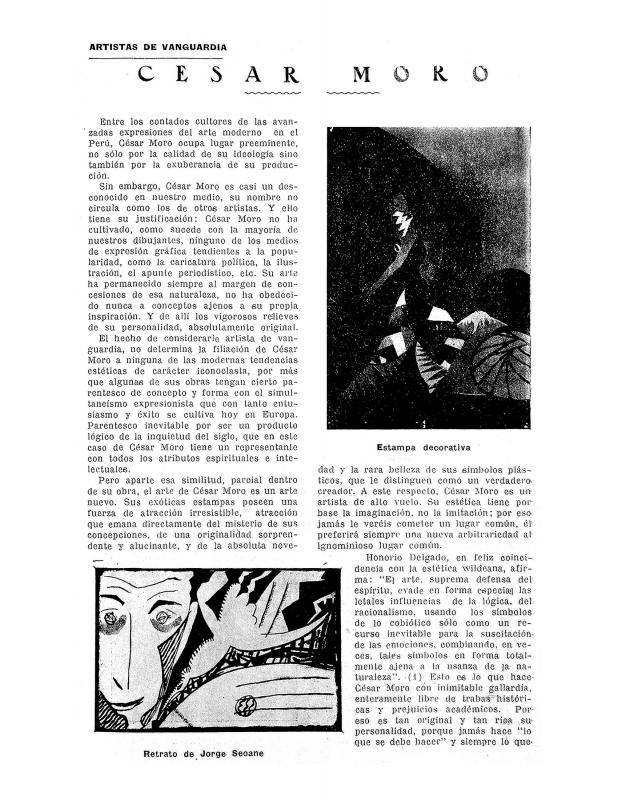These are the observations made on the Surrealist exhibition organized by César Moro (written under the pseudonym “Ruy Barbo”) at the Sala Alcedo in the Peruvian capital. Poet and visual artist César Moro (Alfredo Quízpez Asín) returned to Peru at the end of 1933, after eight years in Paris where he participated in the Surrealist art movement. In May 1935, Moro and Chilean artist María Valencia organized the first exhibition of this trend in Latin America (Sala Alcedo, Lima). The aggressiveness of the works sparked curiosity and debate due to the radicalism of their language, in spite of the limited press coverage that arose from their rejection by the conservative media. The Peruvian capital was at that time also dealing with the political controversy unleashed by the murder of Antonio Miró Quesada Laos and his wife (owners of the influential newspaper El Comercio), which had occurred that same month. One of the few important articles appeared in Cascabel, a weekly newspaper of liberal bent led by Federico More (along with his brothers Ernesto and Carlos). They had maintained a critical stance toward the dominant indigenist art trend and had also promoted some progressive artistic manifestations; it is also probable that they had met Moro in Europe (1926–28), where they had come into direct contact with the avant-garde scene. The same year as the Surrealist exhibition, Ernesto wrote an extensive article on Moro’s work at the Museo Artístico del Hospital Mental de la Magdalena (today known as Víctor Larco Herrera Hospital), and included some of the Peruvian poet’s comments against the work of José Sabogal, director of the ENBA. One year later, Moro’s individual exhibition was reviewed in Cascabel by R. T. [these initials may stand for Ricardo Tenaud, who worked with him on El uso de la palabra magazine (1938)]. Nevertheless, the more extensive critique came from Carlos Raygada, an influential local critic and a longtime friend of the poet [see in the ICAA digital archive the article by Raygada “Artistas de vanguardia: César Moro” (doc. no. 1146756)]. Despite the aforementioned reviews, Moro’s artistic proposals remained on the margins of an arts scene dominated by the nationalist rhetoric of indigenist art. Like his countryman César Vallejo, his leftist political stance led him to organize a campaign in favor of the Second Spanish Republic, which was considered subversive by the government of General Oscar Benavides. The first and only issue of El uso de la palabra appeared in 1938; Moro went on to self-imposed exile in Mexico, where he played a key role in the organization of the Exposición Internacional del Surrealismo (1940). [See also in the archive by Ricardo Tenaud “Exposición César Moro” (doc. no. 1293639)].


